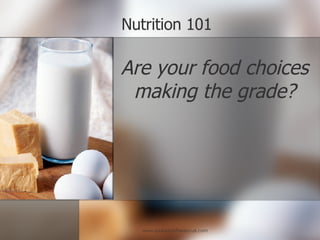Nutrition 101
- 1. Nutrition 101 Are your food choices making the grade?
- 2. ~ You are What you Eat ~ Nutrition is the study of how our body uses the food we eat to maintain our health.
- 3. âItâs good to Eat When You are Hungryâ BREAK FAST
- 4. Hunger v. Appetite They are the same thing right?
- 5. Hunger Hunger is a physiological need for food.
- 6. Appetite Appetite is the psychological desire for food
- 7. Diet A diet is a pattern of eating that includes what a person eats, how much a person eats, and when a person eats.
- 8. Ask the Right questions Why?
- 9. Reasons Why we eat It (food) was there Social (family, holiday, outing) Emotions (anger, sadness, happiness) Someone Else Nervousness Stress
- 10. Factors that affect food choices Personal preference Convenience Cost Cultural Social Religious Availability/Variety
- 11. Body Image Body Image is the way you feel about and perceive your body
- 12. Eating Disorders A disease that involves an unhealthy concern with oneâs body weight and shape. Anorexia Nervosa Self-starvation Extreme weight loss Bulimia Nervosa Binge & Purge Binge-eating Disorder Bingeing
- 13. The latest data from the National Center for Health Statistics show that 30 percent of U.S. adults 20 years of age and older are obese. An estimated 119 million Americans, or 64.5 percent, of adults are either overweight or obese. Centers for Disease Control
- 14. Obesity Obesity is a condition characterized by a large percentage of body fat High cholesterol High Blood Pressure Heart disease Diabetes Stroke Cancer (certain forms)
- 15. Top 10 Leading Causes of Death Top 6 leading causes of death all associated with obesity Heart Disease Cancer Stroke Chronic lower respiratory diseases Diabetes Accidents (unintentional injuries) National Center for Health Statistics
- 17. Dietary Guidelines Guide for healthy eating for Americans age 2 and up USDA & DHHS
- 18. Moderation Moderation Moderation Moderation
- 19. Whatâs a Calorie? Unit of measurement for energy 3 of the 6 nutrients provide us with energy Carbohydrate â 1 g = 4 calories Protein â 1 g = 4 calories Fat â 1 g = 9 calories
- 20. Nutrition Facts
- 21. The Skinny on Fat Fat gives us twice as many calories per gram as carbohydrates and protein Quality v. Quantity
- 22. Serving Size Not a portion, which is the amount of food a person wants to eat; In essence whatever amount you put on your plate A serving size is the amount of food considered healthy for an average adult Need v. Want
- 24. Carb Count Carbohydrates are vital for our diet One of the six essential nutrients Source of energy for the body Similar to gas for the car, our body will not function without carbohydrates.
- 25. Low Carb / No Carb âDietsâ
- 26. Baked Potato
- 27. â Loadedâ Baked Potato
- 28. Load of Calories Butter Sour cream Cheese Bacon Ranch
- 29. 5 A Day
- 30. Add Color to your plate
- 31. Out with the oldâĶ Â Â Â Â Food Guide Pyramid
- 32. In with the newâĶ United States Department of Agriculture
- 33. Letâs get physical Partnership Pedometer Compare yourself to Yourself
- 34. Think outside the ĩþīĮģæâĶ
- 35. ĩþēđēĩâĶ
- 36. Can
- 37. Homework âDietâ Analysis âSuperSize Me for a Weekâ caloric calculations Visit mypyramid.gov
- 38. Evaluation One thing you learned from the presentation A question that the presentation evoked Something you will do as a result of todayâs presentation Additional comments
- 39. Thank you for your time. I have enjoyed meeting with you today. Charlotte R. Williams, MAEd, CHES [email_address] â Providing timely solutions for Community Health needsâ Nutrition 101 Are your food choices making the grade?
Editor's Notes
- #2: Give out m v. factsquiz







































![Thank you for your time. I have enjoyed meeting with you today. Charlotte R. Williams, MAEd, CHES [email_address] â Providing timely solutions for Community Health needsâ Nutrition 101 Are your food choices making the grade?](https://image.slidesharecdn.com/nutrition-101-120019803738304-5/85/Nutrition-101-39-320.jpg)